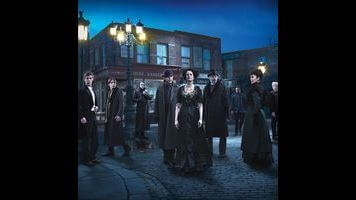A Penny Dreadful bottle episode showcases the incredible Eva Green

At least once per season, John Logan and company get together and decide (with all due respect to the excellent ensemble cast), screw it: this week we’re doing The Eva Green Show. And who can blame them? They know what they have in Green as well as we do: a fearless actress who has no time for pedestrian concerns about vanity or what some might consider to be over the top. The comparison that occurred to me while watching “A Blade Of Grass” is Sheryl Lee in Twin Peaks: Fire Walk With Me. David Lynch’s prequel was unfairly maligned at the time, and Lee was collateral damage. Her performance as Laura Palmer was larger than life, nakedly emotional, and completely overlooked until years later. Green’s Vanessa Ives is in the same category: a deeply felt portrayal of a tormented woman, pushing far beyond the boundaries of naturalism. While Penny Dreadful fans are well aware of the great work Green is doing, her performance hasn’t gotten the mainstream recognition it deserves. (OK, Green did win the prestigious Fangoria Chainsaw Award, but aside from that…) A showcase like this one can only make it harder for awards voters to ignore her.
Superb acting is a requirement for an episode like “A Blade Of Grass,” which is as intimate and minimalist as television gets. Aside from a few shots of Vanessa sitting in Dr. Seward’s office, it all unfolds in Vanessa’s cell at the Banning asylum—or rather, in her memory of that cell. It’s one of the most extreme examples of a “bottle episode” I can recall, which makes sense given the especially lavish production values that have been on display so far this season. None of the other major storylines are given a second of screen time, and only three members of the regular cast appear in the hour. That’s not quite the same as saying only three characters appear, however.
Green’s scene partner for the bulk of the episode is Rory Kinnear, who ends up playing three different roles by the end, none of which are his regular character. Most of the time he’s the kindly orderly who develops affection for Vanessa in the course of his regular duties, leading him to break the rules more and more as time goes on. Through their conversations, we get the back story John Clare has been trying to piece together through his clouded memories. (Among other things, it turns out his young son was sick even before he disappeared from his family’s life.) Kinnear also portrays the manifestations of two ancient demons warring for control of Vanessa: the brothers Lucifer and Dracula.
Kinnear pulls it off convincingly enough, using two noticeably different demon voices to differentiate between devil and vampire. Somewhat counterintuitively, it appears Dracula is the more powerful of the two. Lucifer disdains him for his earthly needs, his eating of flesh and drinking of blood, but Dracula suggests that his brother’s netherworld existence is more tenuous: if people stop believing in him, he will cease to exist. Last week’s apocalyptic portents continue as the vampire reveals his plan to make Vanessa the bride of Dracula and rule over the end times with her. Vanessa shows she can give as good as she gets, rising from the floor and chanting until her tormenters have vanished.
Once they’re gone, it is as Dracula’s familiar said last week of the white room: no time has passed. The orderly is back to being himself, but he has been changed by Vanessa. Where once he believed in the “science” of Dr. Banning’s treatments, he has come around to her view that it’s really torture. In their final scene together, Vanessa’s head is shaved. Unable to convince Banning of her sanity (her belief that she is a vessel of God is all the proof he needs of her lunacy), she is set to undergo a very crude version of a frontal lobotomy. The orderly has told her that the patients who endure this treatment are always left broken if not vegetative, but we already know from the first season episode “Closer Than Sisters” that Vanessa will prove to be the exception. Still, the orderly has come to love Vanessa and despite his need to support his family, he quits his job. He’s seen enough.
Whether Vanessa recognizes that her former orderly and confidant is also her friend John from the cholera dungeon isn’t revealed, but it will certainly be interesting to see what happens when they next encounter each other. If she’s able to fill in some gaps in his memory, it may all come back to him—and maybe he’ll respond with some interesting information about her friend Dr. Frankenstein. One thing we do know for sure: Vanessa now knows Dracula’s name, though she still has not seen his true face. But she has one thing in common with the actress who plays her: she is not afraid.
Stray observations
- Dr. Seward referring to Vanessa’s condition as a “fugue state” is a little suspect, given that the term was first used in the 1901 publication The Mental State Of Hystericals. But I’ll allow it.
- Victorian-era mental health care includes force-feeding the patient through a tube, spraying her with hoses, and gagging her with a primitive Hannibal Lecter mask. Hard to imagine why there wasn’t a higher success rate.
- Unlike John Clare, the orderly hates poetry. He does read to Vanessa from Robert Louis Stevenson’s “My Shadow,” appropriately enough, as shadows of beasts appear on the wall when Vanessa wrestles with her demons.
- The orderly mentions that it’s Christmas, so I guess we can think of this as the official Penny Dreadful holiday special. Festive!